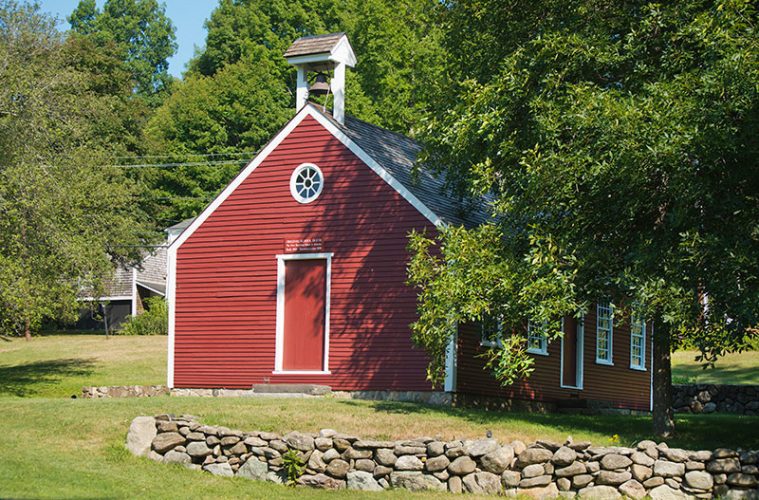Lisa Borgatti will never forget the moment when one of her students at the Governor’s Academy ran up to her brimming with excitement about the party he and his friends were planning to throw together. The reason for the celebration? The electronic meter on their dorm’s water filling station had just alerted them that he and his friends had kept 3,000 plastic water bottles out of landfills.
“It was pretty neat,” says Borgatti, who is a Governor’s Academy science teacher, as well as co-chair of its sustainability committee. Now, she says, there’s a friendly competition between the dorms to see which can divert the most water bottles from landfills.
That enthusiasm and excitement for sustainability is palpable throughout the Governor’s Academy campus, from its students and faculty to its dining services staff and grounds people and beyond. The school, founded in 1763, might predate the United States of America by more than a decade, but its views and actions toward sustainability are anything but old-fashioned. It’s the oldest continually operating boarding school in the country, and it’s also deeply dedicated to the planet.
For more than 250 years, the students and faculty have been stewards of this school and its land that was founded with a bequest from 18th-century Massachusetts Governor William Dummer. Today, the school community wants to continue that stewardship, now and for centuries to come.
“We take that responsibility very seriously,” says Peter L. Mason, Ph.D., the school’s director of marketing and communications. “I think the history of the school and how we were founded is all around.”
The school’s sustainability efforts touch every corner of the campus. There are solar panels on the roof of the Alumni Gymnasium; LED lights in the hockey rink, fieldhouse, and gymnasium; and a new energy management cloud solution run by the school’s Information Technology and Buildings & Grounds departments. The 2016–2017 school year will see the campus go water bottle–free, as well.
In the dining hall, a newly initiated composting program has been a huge success, with the school working with an outside company to compost not only preproduction vegetable scraps but also all pre- and post-consumer food waste. The dining hall also serves locally produced food and cage-free eggs, has eliminated trays, uses reusable dinnerware, and recycles waste oil as biofuel.
It’s not only the school administration working on sustainability efforts, though. The students are a huge part of it themselves.
“The students are coming up with some of the best ideas around the table,” says Christopher Wejchert, CFO and part-time member of the sustainability committee. “They’re very conscientious about their place in the world…the students really do feel that they can make an impact here.”
For instance, the dining hall recently eliminated Styrofoam cups, thanks to a student-run campaign. The students not only came up with the idea but also pitched the plan to the dining services staff, piloted a Styrofoam-free program, and surveyed their classmates about it. Now, instead of Styrofoam, there’s a take-as-you-go ceramic mug station, which includes old mugs that the kids brought from home as well as ones that are made by students at the school’s ceramics studio.
“It was truly impressive that the kids themselves took the initiative to make it happen,” says Borgatti. “It’s something the kids really took on all on their own.”
Wejchert says that as a boarding school, The Governor’s Academy has a compounded responsibility for sustainability, since roughly 600 people live on campus, including students, faculty, and faculty families.
“We’re sort of a microcosm of a town. We basically are a town unto ourselves,” he says. “It’s important not just for the students but for the faculty.”
It’s also important for the students to see that their efforts make a difference on campus, both for themselves and the larger school community. With that in mind, everything is a learning opportunity. For instance, the Governor’s Academy has its own wastewater treatment facility on campus, and its wastewater is released into the nearby Mill River. The science students have worked to test and monitor the quality of both the river water and the school’s wastewater.
“We’re careful about what we put down the drain,” Borgatti says. Through testing, they’ve discovered that “the water that we’re releasing back into the environment is cleaner than the water that’s running through the natural process.”
She adds that it’s “a pretty amazing and powerful tool” for students to see firsthand the impact they can have when they act responsibly.
Deep student involvement in sustainability is evident in other places, too, including the recycling program, which relies on student volunteers who collect recyclables across campus, and the on-campus organic garden, which is planted, tended, and maintained by students.
“It’s not just something run by a teacher,” Borgatti says. “They’re all working together to make that program move forward.”
Moreover, all of this work on sustainability is not only helping the school’s community and larger environment but also preparing students for a world where stewardship will be increasingly crucial.
“We’re here as educators,” Borgatti says. “And these kids are going to inherit the problems of the future.”
![]()
The Governor?s Academy
1 Elm St., Newbury
978-465-1763

